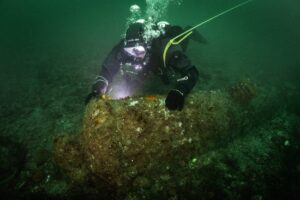When you think of oceanic wonders, majestic dolphins or playful sea otters might come to mind. But let’s not overlook the unsung hero of the sea: the abalone! This quirky marine gastropod, classified in the class Gastropoda of the phylum Mollusca, is found worldwide and belongs to the family Haliotidae and the genus Haliotis—a name that means “sea ear,” reflecting the abalone’s unique flattened shell shape. With some fascinating tricks up its sleeve, the abalone is one of the ocean’s most intriguing residents. Let’s dive in!
Imagine this: an abalone, nestled against a rock, is suddenly touched by a sea star. What happens next is nothing short of spectacular. In a fit of determination, the abalone twists its shell with such ferocity that it dislodges the unwelcome intruder and then “gallops” away—yes, you read that right! While they might not sprint like a cheetah, their unique movement is a sight to behold. Abalone use their muscular foot to create a sort of “galloping” motion as they flee to safety, showcasing that even the most unlikely creatures can be swift when it counts.
The muscular foot of the abalone takes up most of the space inside its shell and is essential for attaching to rocky surfaces. This foot is not just impressive; it’s also a prized delicacy for humans! Abalone hunters often use specialized tools, called abalone irons, to carefully detach these strong molluscs from their homes without injuring them. If the abalone is disturbed, it can clamp down tightly, making it incredibly hard to remove.
While abalone may have the ability to gallop, they’re primarily sedentary creatures. They spend most of their time clinging to rocks, waiting for a delicious piece of kelp to float by. When it does, the abalone clamps down on it with its strong foot and munches on algae using its radula, a tongue-like structure covered with tiny teeth. This radula acts like a mini chainsaw, constantly sharpening its rows of hooked teeth to efficiently scrape algae from surfaces. By grazing on algae, abalones play a vital role in their ecosystems, helping to maintain the balance of their underwater environments. Their feeding habits prevent algal overgrowth, promoting biodiversity and ensuring healthier marine habitats for other organisms.
Abalone shells are truly unique. They feature a single, flat shape with a wide opening and a row of holes along one side, which serve vital respiration, sanitation, and reproduction functions. As the abalone grows, new holes form while older ones get filled in. The typical spiral of a snail shell is reduced to a barely noticeable apex in the abalone, especially in older individuals. Inside, the shell is lined with nacre, or mother-of-pearl, adding an extra touch of beauty.
Thanks to this amazing molecule aragonite (a form of calcium carbonate) abalones can produce pearls just like oysters and clams! When a pesky parasite or a grain of sand lodges itself in their flesh, the abalone responds by secreting layers of shell over the irritant, resulting in a pearl. Some abalone farmers are now even seeding abalone with irritants, hoping to harvest beautiful pearls in the future. Talk about a unique way to create treasures from the sea!
Did you know that abalone blood is a striking blue-green? Unlike ours, which is red due to haemoglobin, the abalone’s unique blood contains hemocyanin instead. This copper-based molecule serves a similar function to haemoglobin, transporting oxygen throughout their bodies but giving their blood that eye-catching hue. Interestingly, the lack of sufficient clotting mechanisms in their blood means that any injury could be fatal. So, while these tough molluscs can gallop away from danger, they remain vulnerable to predators and injuries, making their survival even more remarkable!
Recent research has revealed that abalones may possess remarkable antibacterial and antiviral properties. Studies indicate that compounds found in abalone tissues can inhibit the growth of certain harmful bacteria and viruses, making them a potential source for developing new antimicrobial agents. These findings are exciting not only for marine biology but also for medical research, as scientists explore how these natural defences could be harnessed to fight infections in humans. This adds another layer to the abalone’s impressive repertoire, showcasing how these unique creatures contribute to both their ecosystems and potentially to human health!
So there you have it—the abalone, a remarkable creature that gallops away from danger, boasts blue-green blood, and even produces pearls. With its unique shell, powerful foot, and important role in marine ecosystems, the abalone is truly a superhero of the sea. Next time you find yourself near the ocean, take a moment to appreciate these extraordinary molluscs and the vital role they play in our marine environments!
Written by Lena Ilic.
Photos by Ivana OK.
The post Galloping Through The Sea: The Fascinating Abalone appeared first on Mares – Scuba Diving Blog.
Read MoreDiving, Abalone, Adriatic Sea, biodiversity, marine life, Mediterranean, sea lifeMares – Scuba Diving Blog

